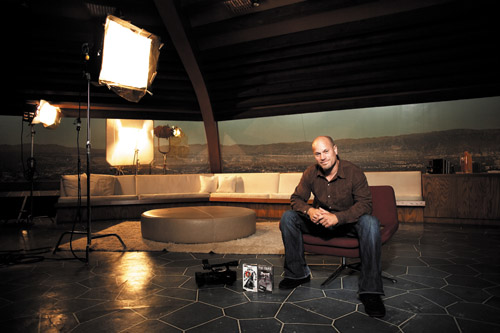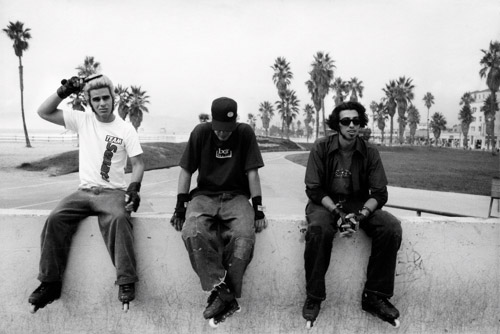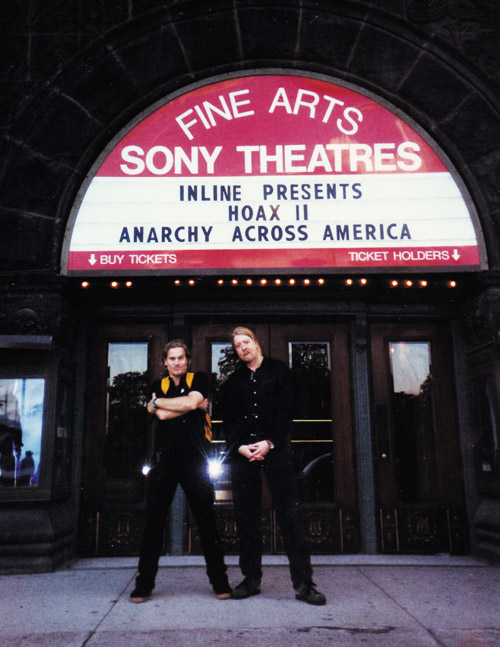
The name Evan Stone may be unknown to some rollerbladers, but his work in rollerblading is legendary. As the man responsible for creating the heavily-influential “Hoax” and “Hoax 2” videos, it was Evan’s vision of rollerblading—both as a sport and lifestyle—that was packaged up and delivered to tens of thousands of skaters around the world at the height of the industry’s popularity during the early ’90s. He captured the attitude and passion of characters like Arlo Eisenberg, Brooke Howard-Smith, B Love, and Brian Smith, which set into motion a series of events that defined the rollerblading identity. From his early days filming skating and working with MTV to creating programming for broadcast television, Evan still remembers the excitement surrounding “Hoax.” Here’s some of what he told Mike Opalek during his interview.

MO: Let’s start out with the basics. How did Evan Stone get into making rollerblading videos?
ES: I was friendly with an owner of a surf shop called ZJ and one of the owners had an idea for a brake for rollerblades. It was called Skidz; it mimicked a roller skate brake. So the guy from the shop said, “There were a couple of rollerbladers who I want you to work with,” so that’s how I met Arlo Eisenberg and Brooke Howard-Smith. I went out and did a promo for this and was really excited to work with these guys. After the piece was done, the product didn’t do very well, but a relationship was started with myself and Arlo and Brooke. Right away we started to talk about doing a movie. I got right on the program because at the time, these guys were doing big grinds all over Venice, and if you look at the “Hoax” you can actually see a few clips where they have these Skidz brakes on. (Evan laughs.) And just at the same time we were talking of making a video, I was working with MTV Sports and Dan Cortez; my freelance chops with MTV were really starting to roll. The next shoot I had with Arlo was a showcase on Venice fashion for a show called “House of Style.” … We’re talking ’92-’93 right now. So after talking a bit, we just started the film. “Hoax” was basically a need, there was one video out there called “Dare to Air,” and we looked at that as look at what else it out there, let’s do something as well but a little more core and little more street style and gritty. My business partner at the time and I started a company called T-Bone Films, not only to do rollerblading films but to service our other clients like MTV and stuff. So we just started going out on my own dime, bought a video camera. We started doing it and got excited about it.
MO: What did you have to overcome when coming out with the first few videos?
ES: When our first video came out, it was pretty interesting ’cause no one really knew too much of any tricks. They were making them up on the spot. I remember Arlo and Brooke making up the soul grind. We were at UCLA, they were going from bike rack to bike rack, frontside to backside. It was really exciting to be there. It was a good shoot. I remember Arlo and Brooke were so venomous with passion; they were like, “Let’s start a sport.” They had the vision and I think it shows in “Hoax 1.” At the time I did “Hoax 1” it was a side project, but we had a feeling that it would sell numbers; we were looking at the dirt bike community and the skateboard community and seeing what numbers they were moving at the time and that was pretty good numbers: 20,000 to 30,000 units. The bigger films like “Crusty Demons” were selling like 80,000 to 100,000, and rollerblading was just taking off, so on the business end we knew it was a great idea. We put up, overall, about $17,000 for “Hoax 1.” It was all shot on High 8 and 16mm film. Only thing to overcome was to finish it. You almost have to abandon it, ’cause there are always new tricks coming out. Here’s a good one: The only thing to overcome was Arlo and Brooke telling me that I should make my film and call it Senate. The film took a while to make — about a year — and at the time there was a video distribution company just starting called Video Action Sports, and they’re really, really big now, but they started with rollerblading videos, just like a lot of people start in rollerblading even though they won’t say it anymore. … We’re not going to name names. But Video Action started with rollerblading, and we helped that company grow. “Hoax 1” sold pretty good numbers at the time — it was about 12,000 to 15,000 units ¬— and right there we knew it was on.

MO: How did you come up with “Hoax 2”?
ES: At the time of “Hoax 2,” I was working for MTV Sports a lot and we did a feature on Arlo, and it came out really good — you could probably YouTube that one. “Hoax 1” and “Mad Beef” made some good money and we wanted to step it up — and at heart I’m an actual filmmaker, shooting film, shooting the higher formats — and we wanted to flex out and show our filmmaking skills. At the time, we had a great relationship with Hyper wheels, who pretty much funded the video and so did Roces. So basically “Hoax 2” was funded before it went on the road, totally paid for; we were in the red before we left, which was a good business decision for us. At the time, doing a lot of stuff for MTV, it was the early days of reality television, and I’ve always been into that kind of stuff. So “Hoax 2” was our time to get out there and flex.
MO: What have you been doing since you stopped making rollerblading videos; where has your career taken you?
ES: After I stopped making rollerblading films, I started to really step up with MTV and went on to produce other major television shows like “Amazing Race,” countless shows for MTV, VH1, NBC. I started getting into television directing more. My career outside of action sports began to soar. But I never stopped loving that independent feeling of making product for the masses, and I kept doing that even on the side while I was working my other jobs. I put out a sport bike series called “12 O’clock”/“Urban Street Bike Warriors.” It’s about nine DVDs in total, and it’s about those crazy dudes on the highway doing wheelies on their sport bikes. I also did a car series and basically kept that going. I never got out of making those independent movies. After the rollerblading market went soft, people were starting to get their action sports fix online and stuff. I had to move over to more television production. But I must say, back in the old days when I shot “Hoax 1,” “2” and “3,” those where some of the best days as a filmmaker in my life!
Read the rest of Mike Opalek’s interview with Evan Stone in Issue #7 of ONE, on sale now!
i like how one don’t just right about tours and stuff. They write about something interesting.
peace
toldandretold.com
That was Awsome … I do feal that one day, that we all gonna get that HOax feeling again….
ive been waiting to read this issue for a while now but i think you guys forgot to mail me mine
I thought T-Bone went big in the porn business!
Yeah I heard Evan Stone was big in the porn scene? Either way T-Bone was sickk!
where can i buy a copy of mad beef?
Leave a Reply to sam nicholls Cancel Reply